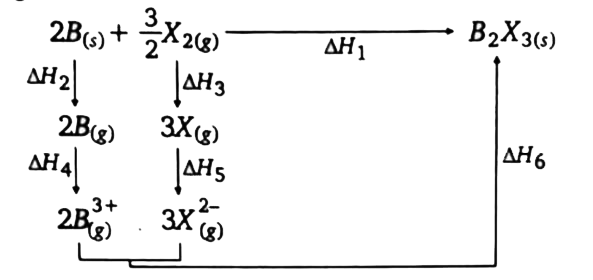Consider the following two reactions :
(i) Propene +H2→Propane, ΔH1
(ii) Cyclopropane+H2→Propane, ΔH2
Then, ΔH2−ΔH1 will be
0
2BEC−C−BEC=C
BEC=C
2BEC=C−BEC−C
The correct Answer is:B
CH3−CH=CH2+H2→CH2+H2→CH3−CH2−CH3,
ΔH1=(BEC=C+BEH−H)−(2BEC−H+BEC−C)

Topper's Solved these Questions
- THERMODYNAMICSBOOK - NCERT FINGERTIPSCHAPTER - THERMODYNAMICSEXERCISE - NCERT Exemplar
11 Videos
- THERMODYNAMICSBOOK - NCERT FINGERTIPSCHAPTER - THERMODYNAMICSEXERCISE - Assertion And Reason
15 Videos
- THERMODYNAMICSBOOK - NCERT FINGERTIPSCHAPTER - THERMODYNAMICSEXERCISE - Gibbs Energy Change And Equilibrium
4 Videos
- THE S-BLOCK ELEMENTSBOOK - NCERT FINGERTIPSCHAPTER - THE S-BLOCK ELEMENTSEXERCISE - Assertion And Reason
15 Videos
Similar Questions
Knowledge Check
The equation ΔH=ΔH1+ΔH2ΔH3
AKirchoff s equationBvant't Hoff isothermCvan 't Hoff isochoreDHess's lawConsider the reactions
(i) S(rhombic)+3/2O2(g)→SO3(g),ΔH1
(ii) S(monoclinic)+3/2O2(g)→SO3(g),ΔH2
(iii) S(rhombic)+O3(g)→SO3(g),ΔH3
(iv) S(monoclinic)+O3(g)→SO3(g),ΔH4AΔH1<ΔH2<ΔH4 (magnitude only)BΔH1<ΔH3<ΔH4 (magnitude only)CΔH1<ΔH2=ΔH3<ΔH4 (magnitude only )DΔH1+ΔH4=ΔH2+ΔH3For the equations
C(diamond)+2H2(g)→CH4(g)ΔH1
C(g)+4H(g)→CH4(g)ΔH2 Predict whtherAΔH1=ΔH2BΔH1>ΔH2CΔH1<ΔH2DΔH1=ΔH2+ΔvapH(C)+ΔdissH(H2)
Consider the following reactions
(i) A(s)→A(g):ΔH1
A(g)→A+(g):ΔH2
A+(g)→A2+(g):ΔH3
then according to the given information, select the correct statement(s)
View SolutionIf X(g)−→X(g)2+3e−ΔH1=900kJX(g)→X(g)2+ΔH2=650kJ
Then find ΔHeg of X.
View SolutionFormation of a solution from two componenets can be considered as :
(i) pure sovent → separated solvent molecules, △H1
(ii) Pure solute →separated molecules,△H2
(iii) separated sovent and solute molecules→solution, △H3
solution so formed will be ideal if :
View SolutionFormation of a solution from two componets can be considered as :
(i) pure solvent → separated solvent molecules, △H1
(ii) Pure solute →separated molecules,△H2
(iii) separated solvent and solute molecules→solution, △H3
solution so formed will be ideal if :
View SolutionConsider the following Born-Haber's cycle:

(Where ΔH1,ΔH2,ΔH3,ΔH4,ΔH5andΔH6 are in kJ/mol)
Then according to given information the correct statement is/are:
View Solution
